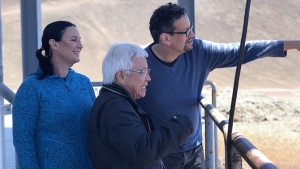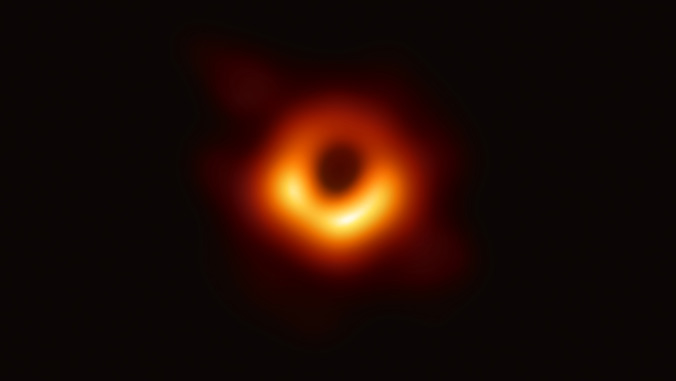
Two of the world’s most powerful telescopes, located atop Maunakea on Hawaiʻi Island, played a vital role in producing the world’s very first image of a black hole that now bears a Hawaiian name.
Hawaiʻi-based James Clerk Maxwell Telescope (JCMT) and Submillimeter Array (SMA) are part of the unprecedented Event Horizon Telescope project. JCMT is operated by the East Asian Observatory, SMA is operated by the Smithsonian Astrophysical Observatory and the Academia Sinica Institute of Astronomy and Astrophysics.
Astronomers collaborated with renowned University of Hawaiʻi at Hilo Ka Haka ʻUla O Keʻelikōlani Hawaiian language professor and cultural practitioner Larry Kimura for the Hawaiian naming of the black hole. Pōwehi, meaning embellished dark source of unending creation, is a name sourced from the Kumulipo, the primordial chant describing the creation of the Hawaiian universe. Pō, profound dark source of unending creation, is a concept emphasized and repeated in the Kumulipo, while wehi, or wehiwehi, honored with embellishments, is one of many descriptions of pō in the chant.
“It is awesome that we, as Hawaiians today, are able to connect to an identity from long ago, as chanted in the 2,102 lines of the Kumulipo, and bring forward this precious inheritance for our lives today,” said Kimura. “To have the privilege of giving a Hawaiian name to the very first scientific confirmation of a black hole is very meaningful to me and my Hawaiian lineage that comes from pō, and I hope we are able to continue naming future black holes from Hawaiʻi astronomy according to the Kumulipo.”
- You may also be interested in: Maunakea telescopes win the ‘Oscars of Science’ for Pōwehi, September 6, 2019

In April 2017, a groundbreaking observational campaign brought together eight telescopes at six locations around the globe to capture an image of Pōwehi, a supermassive black hole at the center of the Messier 87 galaxy. The announcement was made to the world on April 10.
“Maunakea makes this discovery and the spectacular image of Pōwehi possible,” said Jessica Dempsey, deputy director of JCMT. “Its perfect remote position, and the dry conditions on Maunakea’s summit, allow JCMT and SMA to collect the tiny amount of light that only touches our planet in a few very special places. Like the mountain itself, every drop of light we gather is precious.”
The SMA and JCMT telescopes are key members of the Event Horizon Telescope project, which links together strategically placed radio telescopes across the globe to form a larger, Earth-sized telescope powerful enough to see a lehua flower petal on the moon.
- Related: Rep. Case Speaks on House Floor on First Image of a Black Hole, YouTube, April 10, 2019


